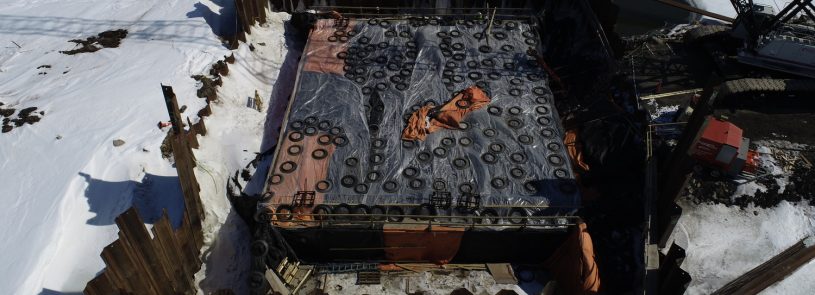Curing concrete in cold weather? Follow these tips.

By Steven Myer
Freezing weather doesn’t have to shut down bridge construction. But steps must be taken to protect the concrete on those days to allow it to cure properly and thereby gain the full design strength.
IMEG and Sioux Falls Construction took cold-weather measures recently when we completed a cast-in-place reinforced concrete box culvert project on Day County Highway 1 over Blue Dog Lake in Day County, SD. The average temperature during construction was 12 to 17 degrees F.
In temperatures like that, the water in the concrete will freeze, which means that it will not react with the cement in the concrete mix. This will weaken the concrete and ultimately could result in concrete failure.
The South Dakota DOT Spec Book mandates that concrete must be kept above 50 degrees for the first three days after it’s poured, then above 40 degrees for two more days. After this, the temperature of the concrete cannot drop by more than 40 degrees in any 24-hour period.
What can you do to keep the concrete warm and keep the job moving? There are two strategies.
When the weather is not too cold, you can cover the freshly poured concrete with thermal blankets while it cures and the heat from the chemical reaction of the curing concrete will be trapped thereby keeping the concrete above the temperatures required to protect the concrete.
When the weather turns colder, however, the thermal blankets may not be enough. In those cases, the concrete must be housed and heated. This involves building a wood frame and enclosing that with tarps, then a portable heater (or heaters) is used to maintain the required temperature thus protecting the freshly poured concrete. During the housing and heating process, extra water may be needed to add humidity to keep the surface from drying out. One other possible problem with the housing and heating strategy is that the concrete may get too warm (more than 100 degrees) which can also damage the concrete.
Whichever strategy is used to protect the concrete, you must continuously monitor the temperature of the concrete to ensure that it stays within the specified range. If it does fall below those temperatures, the number of days that the concrete must be protected will be extended by one day for each day that the specified temperature is not maintained.
On the Day County job, we used a combination of both strategies. Some of the days, the thermal blankets were enough to maintain the required temperatures, but when the weather turned extremely cold, we had to house and heat the concrete.
In many states, if a contractor wants to pour concrete between November and April, they need a housing and heating plan. It may seem like extra work, but planning for cold weather will improve the quality of construction and save time and money in the long run.
Learn more about the Day County project.












